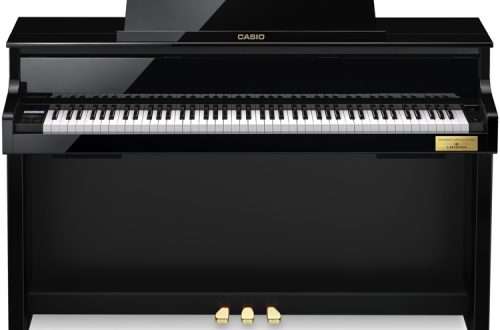
How to choose an electric guitar?
Contents
An electric guitar is a type of guitar with pickups that converts the vibrations of the strings into an electrical signal and transmits it through a cable to an amplifier.
The word ” electric guitar ” originated from the phrase “electric guitar”. Electric guitars are usually made from wood. The most common materials are alder, ash, mahogany (mahogany), maple.
In this article, the experts of the store “Student” will tell you how to choose exactly the electric guitar that you need, and not overpay at the same time. So that you can better express yourself and communicate with music.
Electric guitar construction

Electric guitar construction
- The neck consists of the front surface on which the metal nut is located; it is also called the fretboard .
- The body is usually made of several pieces of wood glued together; however, high-quality guitars have the body made from a single piece of wood.
- Pickups – pick up the sound vibrations of the strings and convert them into an electrical signal.
- Headstock a _
- Kolki . They are used to lower and tighten the strings, as a result of which the instrument is tuned.
- Stand ( bridge -machine) – a structural element, fixedly fixed on the body of the guitar; designed for attaching strings.
- The volume and tone controls are used to adjust the volume and change the tone of the sound that we subsequently hear through the amplifier.
- Connector for connecting to the amplifier – the connector where the plug of the cable from the amplifier is connected.
- Nuts and frets . A nut is a metal insert, and a fret is the distance between two metal nut.
- Pickup selector This switch switches between the available pickups, resulting in a different guitar sound.
- Strings .
- Upper nut .
- The lever is used to change the tension of the strings; moves the stand to produce a vibrating sound.
Guitar shape
Some may say that the form is not that important or something like that, but I think the guitar should inspire, you should want to play it! And this is where the shape of the guitar can help, so below are a few shapes of guitars, take a closer look and find what you like.
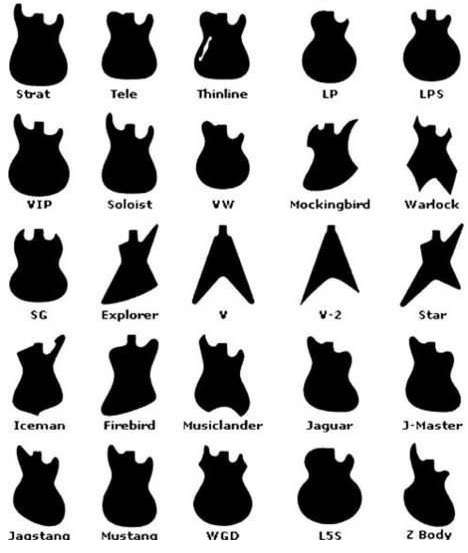
After that, try to build on the shape of the guitar you want, because if the guitar is not pleasant to hold in your hands, then no matter how it sounds, you will not lose on it for a long time!
Do not think it is convenient or not, most likely you will get used to it very quickly, and after that, for you, other forms will seem wild and not at all correct.
Important Tips When Choosing an Electric Guitar
1. First of all, make an external inspection of the electric guitar. There should be no visible defects on the body and neck e: cracks, chips, delaminations.
2. Do not immediately connect the electric guitar to the amplifier, first listen to how the individual strings sound . They should not stand out in volume. If you notice that the sound of the guitar is too muffled and sounds dull, it is worth continuing the search.
3. Then carefully inspect the neck of the guitar.
Here are a few highlights:
- the neck must be tried by touch, the neck should be comfortable and comfortable to hold . This is very important at the initial stage, in the future, as you gain experience, you will be able to play and adjust your hands to any neck .
- the height of the strings above the fretboard in the region of the 12th fret and should not exceed 3 mm (from the string to the fret a), when extracting sounds, the strings should not beat against the frets and rattle . Play each string on each fret .
- frets should not be too wide. Nothing should interfere with the fingers. It should be pleasant and convenient to play.
- look along the neck a, it should be absolutely even . If it is bent in any direction, it is difficult to fix it and, accordingly, you should not buy such a guitar.
- also check how the neck is attached to the body: there should be no gaps, this significantly affects the feedback of the guitar and the sustain (this is the duration of the note after it is played, in other words, the decay rate of the note we played).
- also look carefully at the nut , it must be securely fixed on the fretboard , the strings in the slots should not move freely.
4. Now you can connect the selected instrument to the amplifier, play something, but extract sounds on different strings and frets , listen. You should like this sound .
5. You need to check the sound of each pickup separately, turn the tone and volume controls – the sound should change evenly without any jumps, when you turn the knobs they should not wheeze and crunch.
6. Now you need to carry out the main check. Play something familiar on the guitar, or ask a friend if you don’t know how. Now answer the following questions for yourself: did you like the sound? Are your hands comfortable? Ask the seller to play the guitar, or your friend whom you called with you and listen to the sound of the guitar from the side.
7. You also need to ask yourself the question: do I like the external condition of the guitar? Do not be shy, this is also important when choosing a tool. The guitar should make you want to pick it up and play it. After all, it’s not by chance that guitars of the same brand, year, country of manufacture differ in price, and it’s all just in the color of the guitar. For example, Fender guitars in sunburst color are more expensive than other Fenders of the same level
Mensura
Mensura (Latin mensura – measure) is the distance from the nut to the stand. Scale is one of the main factors that affect the sound of the guitar. Most often you can find guitars with a scale of 603 mm (23.75 inches) and 648 mm (25.5 inches).
The first scale is also called the Gibson scale, because this is the scale that most Gibson guitars have, and the second scale is Fender, because it is typical for Fender guitars. The larger the scale on the guitar , the stronger the tension on the strings. Large scale guitars require more effort to play than small ones.
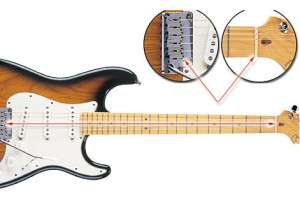
mensura
The most optimal scale – 647.7 mm
You can’t tell for sure by eye, but be sure to pay attention to this “detail”. Ask the seller what scale your preferred guitar has and compare it with the specification above, small deviations are acceptable, but still treat this choice very carefully!
Neck attachment
Screwed neck – the name speaks for itself, its advantages are that it is possible, if necessary, to replace the guitar neck without any problems or repair an existing one.
Glued neck – again, everything is clear, but with such a neck you will have to go to the end, since you definitely cannot remove it without harm to the guitar. Again, as an example of such necks , I cite a guitar – Gibson Les Poul.
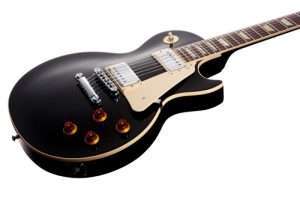
Through neck – such a neck is one piece with the body, it is not attached in any way and that is why it has a rather large advantage over the rest. That’s why – because of this method of attachment, you will have access to the “upper” frets (beyond the 12th fret )!
Pickups and electronics
Pickups are divided into two groups – singles and humbuckers . Singles – have a bright, clear and crisp sound. As a rule, they are used in blues and jazz .
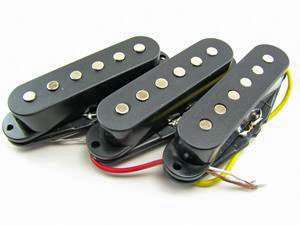
Singles _
Among the shortcomings, it can be noted that in addition to the sound of the strings, extraneous noise or background can also be heard.
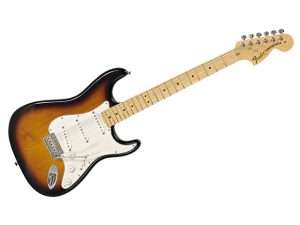
Popular guitar with singles – Fender Stratocaster
To combat the disadvantages of singles in 1955, Gibson engineer Seth Lover invented a new type of pickup – the “ humbucker ” (humbucker). The word “humbucking” means “humbucking ( from mains) AC”. The new pickups were designed to do just that, but later the word “ humbucker ” became a broader term for a specific type of pickup.
The sound of the humbucker a turns out to be poorer, lower. On a clean sound, they give out a smoothed round sound, with an overload they sound aggressively, clearly and without background. An example of a humbucking guitar is the Gibson Les Paul.
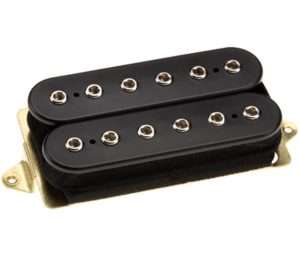
Humbucker s
How to choose an electric guitar
Examples of electric guitars
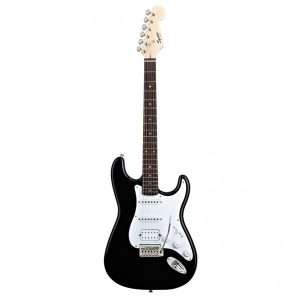 FENDER SQUIER BULLET STRAT TREMOLO HSS |  EPIPHONE LES PAUL SPECIAL II |
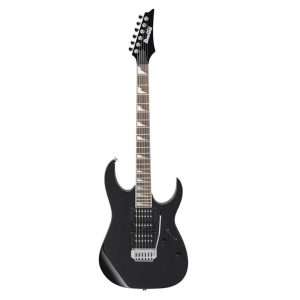 IBANEZ-GIO-GRG170DX |  SCHECTER DEMON-6FR |
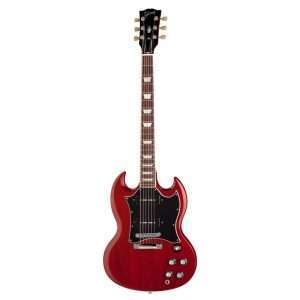 GIBSON SG SPECIAL HERITAGE CHERRY CHROME HARDWARE | 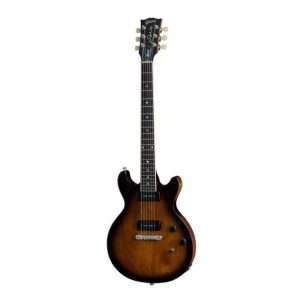 GIBSON USA LES PAUL SPECIAL DOUBLE CUT 2015 |
Overview of the main manufacturers of electric guitars
Aria

Originally a Japanese brand with a claim to legend, founded in 1953. The heyday of the company was in the mid-70s, the last Japanese guitar was released in 1988, later most of the production moved to Korea. At the moment they are engaged in almost all types of guitars, including ethnic musical instruments, but are known primarily for their electric guitars .
Nothing really stands out, products – everything from budget models to professional ones. They did not come up with any innovations, all products are typical copying of products of more “hurried” competitors.
Cort

One of the largest manufacturers of musical instruments in the world. All products have already won a positive reputation due to low prices and good quality. Most of the production is concentrated in South Korea, they are famous, first of all, for their electric guitars and acoustics.
In my opinion, it is acoustics that stand out, since it is she who has a very good ratio of appearance / price / quality and sound. With budget electric guitars , the situation is a little different, they need to be looked at more carefully, although they also have a good balance of quality. All products are unequivocally recommended for use.
Epiphone
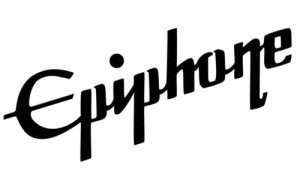
A musical instrument manufacturer founded in the city of Izmir (Turkey) already in 1873! In 1957, Gibson bought the firm and made it its own subsidiary. Currently, “Epifon” is successfully selling budget, Chinese Les Pauls to all those who suffer, and I must say, they are selling successfully.
But here’s what’s interesting – reviews on their products vary very much, someone likes these Les Pauls madly, someone, on the contrary, considers these guitars completely unacceptable, otherwise it’s up to you.
ESP

A well-known Japanese musical instrument manufacturer that recently celebrated its 30th anniversary. It is interesting, first of all, for its budget electric guitars , which have an enviable quality and good sound characteristics. A number of famous musicians such as Richard Kruspe (Rammstein) and James Hetfield (Metallica) use such guitars in their concerts and in recording studios.
Most of the production is concentrated in Indonesia and China. In general, ESP products are of very high quality, without pretense of elitism and enjoy well-deserved popularity.
Gibson
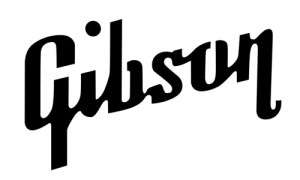
The most popular American company, manufacturer of guitars. The firm’s products can also be seen under the brands Epiphone, Kramer Guitars, Valley Arts, Tobias, Steinberger and Kalamazoo. In addition to guitars, Gibson makes pianos (a division of the company – Baldwin Piano), drums and additional equipment.
Company founder Orville Gibson made mandolins in Kalamazoo, Michigan in the late 1890s. In the image of the violin, he created a guitar with a convex soundboard.
Ibanez

Leading Japanese (despite its distinctly Spanish name) musical instrument company worldwide on a par with Jackson and ESP. Without exaggeration, it has the widest range of bass and electric guitars. Perhaps the first real contender for legend after Fender and Gibson. Ibanez guitars are played by many famous musicians, including Steve Vai and Joe Satriani.
Everything is supplied to the market, from the most budgetary and inexpensive to the most advanced and professional guitars. The quality of the guitars is also different, if everything is clear with the Japanese professional “Aibanez”, then inexpensive models of guitars may raise some questions.
Schecter

An American company that does not disdain the production of its instruments in Asia. They are similar in quality to the budget (and slightly higher) Aibanez guitars, although they differ from the latter in greater “love” for good fittings and a more affordable price. For beginner guitarists, this is it.
Yamaha

The famous Japanese concern for the production of everything and everyone. But in this case, they are interesting with their guitars. To begin with, I want to highlight the quality with which these guitars are made – it is very, very good, one might say indicative, even for budget instruments.
In the Yamaha product line of guitars, everyone can find everything, from a beginner to a pro, and that, I think, says it all. The product is definitely recommended for use.



